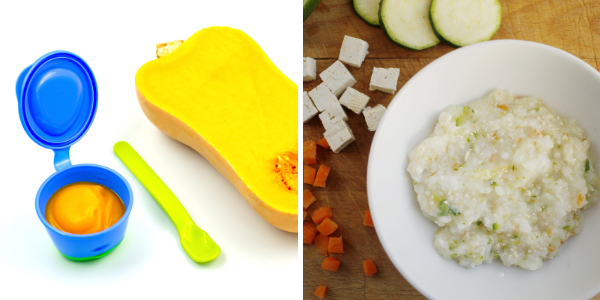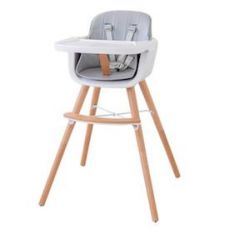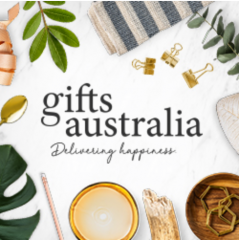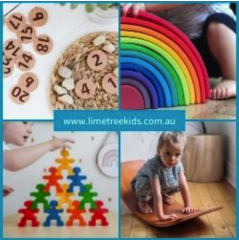Encouraging Feeding Skills Eat Suitable for stages: 6 - 12 Months, 12 - 18 Months, 18 - 24 Months
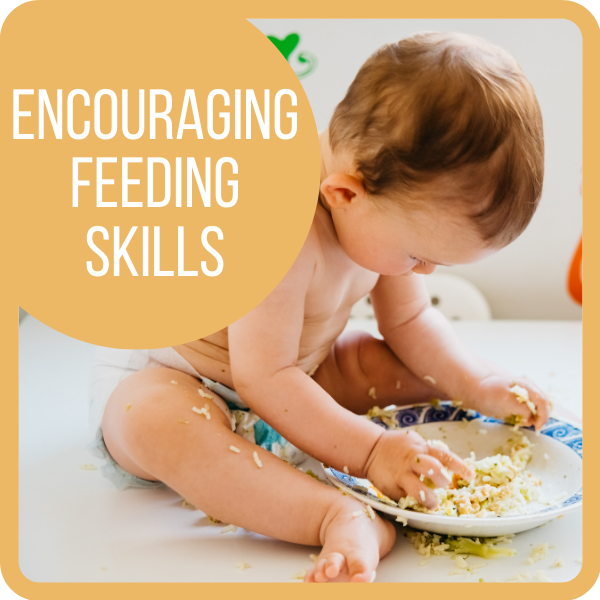

It takes a long time for your baby to develop the complex sensory and motor skills they need to feed themselves.
For starters, they are still having teeth emerge - their gums can be sore, and chewing can be a challenge when you don't have many teeth. As each tooth emerges, your baby will have to adjust to chewing with their new tooth.
Your baby is still developing hand skills for grabbing food or putting a spoon into their mouth. Their hand grasp and fine motor skills will emerge over their first years. Feeding using a combination of utensils and their fingers/hands is a great way of practising their grasp, and motor planning with hand/eye/mouth coordination to get the food into their mouth.
Further, their jaw, tongue, cheeks and lips which are so good at sucking, now have to learn new movements to chew and move the food to the back of their throat for swallowing. At the same time, they need to coordinate breathing with swallowing and managing saliva.
Feeding provides a full sensory experience. Your baby has to manage and learn the sensations of the new tastes and textures in their mouth. They can smell the food and explore and feel the food with their hands. This exploration helps them to categorise all the characteristics of the food (flavour, smell, colour, and texture) to store the memory of the food for the next time they encounter it.
Feeding also involves communicating what they want and don't want as well as developing a relationship with food and language around food and eating.
Their feeding skills will be built over time, through exploration, practice and lots of mess. Then, even when they can do it themselves, they might want you to continue to feed them, and at other times, they will want to do it themselves.
Mealtimes are more than just eating for nutrition. Mealtimes can be a social event where everyone can sit together, and they are about enjoying the food that has been prepared. Snack-time, by contrast, is usually more about having a quick feed while doing another activity or to get back to doing that another activity quickly.
There are two main approaches to mealtimes:
- spoon-feeding
- finger foods (baby-led weaning style)
It's possible to use one or both of these approaches with your baby. Lots of parents choose a combination to suit different everyday situations and moods. For both options, you'll want a good easy clean bib to catch the spills when they need to be dressed. For worry-free, laundry-free feeding, try stripping them down to their nappy, afterwards, wipe them down with a washer or pop them straight in the bath.
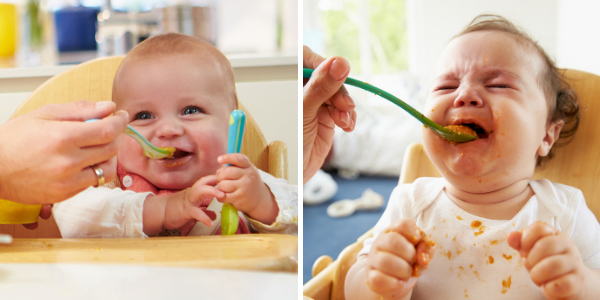
Spoon-feeding is better when you are in a rush, need to be clean or are out and about. It is also mostly for pureed or liquid food such as yoghurt. Your baby will usually want to be involved with feeding, so you may want to offer a spoon for your baby to hold, chew on and play with in addition to the feeding spoon that you control.
You can make your own food baby food by steaming and blending fresh foods.
To make this easy, you can buy a Steamer Blender Baby Food Preparation Unit or the Beaba Babycook and then put the puree into one of the following:
- reusable food pouch available from Cherub Baby
- boon squirt feeding spoon (available from the Baby Bunting eBay Store)
- a bowl
- insulated food jar available from The Stork Nest.
Feeding out of a food pouch can be made easier by attaching a universal food pouch spoon or soft spout also available from Cherub Baby.
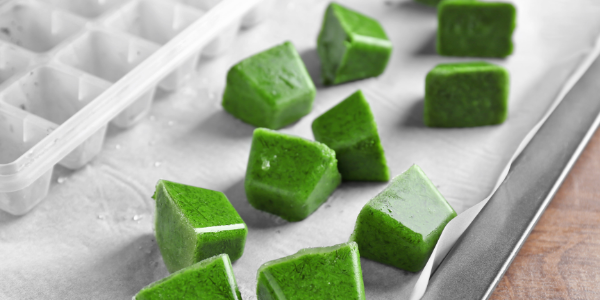
To store baby food, you can freeze in Freezer Trays or Freezer Containers including Oxo Tot Glass Storage containers. Glass is great as it can be frozen and heated safely and also used to eat out of.
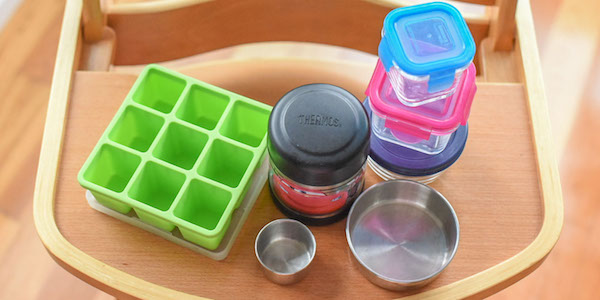
It's a good idea to have a range of feeding utensils or a food feeder for your baby to try, all should be safe for them to chew on as they will use them for teething while they are tasting the food.
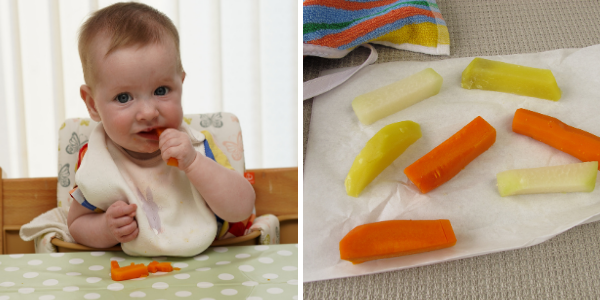
The Baby-Led Weaning (BLW) approach can be used once your baby can bring finger foods to their mouth, and can move food around their mouth. The idea is to offer pieces of food that are on the softer side, which are the right size for your baby to pick up. The ‘Weaning’ in BLW refers to the gradual move away from milk feeds to family foods at the pace as decided by your baby. It requires some patience as it takes time, and you need to be ok with some extra mess, but it allows your baby to explore their food using all their senses which will help them learn faster about tastes, textures and how to manage them.
The BLW approach can have advantages for the whole family to move to healthier eating, as your baby is offered elements of the family foods. When you know your baby will be eating the same food as you, this encourages you to cook more whole plant-based foods, low in salt and sugar, and low in trans-fats. This sets up the whole family to develop and model healthy food choices, enjoy eating together, and allow your baby autonomy over how to eat, how much to eat and which foods to eat.
The main concern that parents have with this approach is that their baby will choke. It can be nerve-wracking the first time you hear your baby gag on their food, you can think they are choking, but the sound is distinctly different. Gagging is where they bring the food from the back of their mouth to the front with a cough like sound. Once the food is back to the front of their mouth, they will either keep chewing it or spit it out. When your baby is first learning how to eat, it is quite normal for them to gag on their food. It is all part of them learning how to move the food around their mouth, and due to having a very gummy chew before their teeth emerge.
To reduce the risk of choking, it is important to provide appropriate size and softened foods to your baby as discussed in the topic, Your Baby's First Foods.
As your baby gets better at feeding themselves with their hands, you can let them experiment with a spoon or fork, or eating out of a food pouch. They will delight in their newfound independence.
For taking finger food snacks out:
- Reusable food bags
- Stainless steel lunch box - easy to clean, food-safe, robust.
- Bento boxes - provide compartments for separating snack foods in one container, easy to clean, food-safe, and robust.
If you want to read more about Baby-Led Weaning - check out the range of books on the subject available from Amazon Au.
Wishing you mealtime fun!
Please note: Above all, any information on this website aims to provide general ideas for informational and educational purposes only. We encourage users to investigate several information sources, including, where necessary, independent individualised medical advice before making any decisions that could affect you or your child’s health or wellbeing.
* BabyPeg participates in various affiliate programs and may earn a commission for referring our users through the links provided. This is at no additional cost to our users. We take great care in choosing products and services which align with the mission of promoting better health and wellness for our BabyPeg community. Where possible, products are tried and tested by us. To continue to provide BabyPeg as a free service and reach as many parents as possible, we appreciate your support in using the link provided to purchase if you decide the product is right for you.
